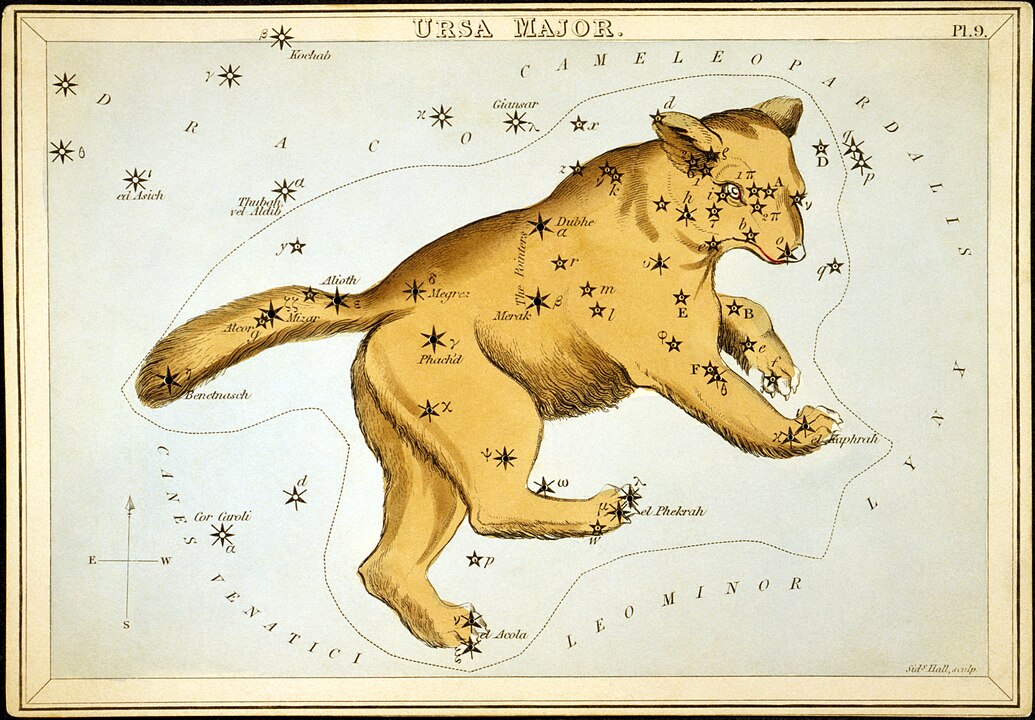Adorno's Constellations (3)
In the last posts, we covered the basics to understand Adorno's concept: the metaphysical issue at stake and Hegel's response. We also established that according to Adorno, concept and object are in a negatively dialectical relation. Please, if you didn't read them, take the time to do so before reading the following. For those who did, I'm going to pick up where we left off: Adorno's big idea to consider the non-identical as a limit-concept.
First, I'd like to quote Adorno's Negative Dialectics :
The unifying moment survives without a negation of negation, but also without delivering itself to abstraction as a supreme principle. It survives because there is no step-by-step progression from the concepts to a more general cover concept. Instead, the concepts enter into a constellation. The constellation illuminates the specific side of the object, the side which to a classifying procedure is either a matter of indifference or a burden.[1]

Ursa Major, Astronomical chart showing a bear forming the constellation
For Adorno, this citation is not quite as astonishing as you could think, and it's a very good definition of a constellation. The first sentence is clearly aimed at traditional (Hegelian) dialectics: Adorno eliminates Hegel's sublation (Aufhebung) and stops at the first negative movement of contradiction. And, of course, his version of dialectics doesn't lead to an higher-order abstraction. I said of course for because of three well-known reasons:
- Negative time negative does not necessarily equal a positive, that's a Hegelian (or rather a scientific) trap. We are not in a mathematical space here. Negating the negation is not a way to produce a positive outcome. A supreme principle – as positive as that might sound – is not what Adorno is looking for.
- Practice does not come second to theory, so the unifying moment can't be a mere abstraction.
- Adorno's dialectics does not need the negation of negation because it doesn't "resolve" itself into an identity process but into a differential one. Adorno acknowledges the difference between an object and its contradiction, and, if I can say this easily without distort too much the original thought behind all this, pure difference is the result of the dialectical process.
This short section reveals us another feature of the constellation: the unifying moment survives because it is not a continuous specification. We don't hop on concepts and jump from a concept to another concept to a generalization or a specification ad infinitum. On the contrary we look at the object and see a conceptual constellation appear where all concepts have a specific position towards one another (they are interlinked in terms of spacing), confront each other and distribute dynamic balances of power between themselves. And where the series of concept is rather static in it's form, the constellation is a mobile apparatus. All these relationships are evolving, and sometimes new concepts emerge from the constellation: the history of the object – what it went through – is recorded by the constellation. So, let me insist here, we've gone from a linear thought – a concept has a relationship with its following or preceding neighbor, like an accumulation of concepts fitting into categories – to an ever evolving multidimensional idea where concepts of the constellation have a necessary role to play, not alone, by as a developing group of concepts. This is precisely their role as a member of the group and the tensions they reveal that shades light on the singularity of the object.
Adorno hammers it in with the last sentence of this citation. I will make a detour by the German version which is definitely clearer than this English translation: "Diese belichtet das Spezifische des Gegenstands, das dem klassifikatorischen Verfahren gleichgültig ist oder zur Last." The ambiguity lies in das Spezifische des Gegenstands which for me doesn't translate well into the specific side of the object. My humble attempt at this translation would be the particular of the object – we are looking at singularity here, something proper to the object, something that makes it stand out of other objets, and not just "a specific side".
Adorno seems to check all the boxes. He does not define what a singularity is, uses concepts to get to the non-conceptual, the non-identical (that's the same) and what seemed to be lost for ever or never represented by previous viewpoints – the historicity of an object – finaly gets the place it deserves in the being of this object.
Next time, I'd like to close this series on Adorno's Constellations with a critique and an assessment of whether or not Constellations can still be used today.
Find Paul Dablemont on mastodon | Get Philosophical Annexes in your inbox | © 2024 Paul Dablemont. All rights reserved.
T. W. Adorno, Negative Dialectics, Continuum, New-York, 1983, p. 162 ↩︎